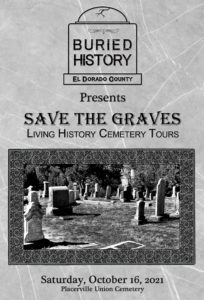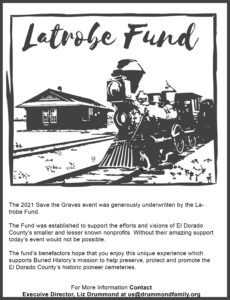

On Saturday, October 16, 2021, nearly 600 guests visited Placerville Union Cemetery to learn about local pioneer history while strolling the cemetery grounds. We presented eight notable, historical figures from El Dorado County through living history performances . Each character was painstakingly researched and the performances were crafted to show each of the departed the respect they deserve.
Proceeds from Save the Graves Cemetery Tours help carry out Buried History’s mission to protect Pioneer Cemeteries of El Dorado County.
Meet the Characters
Harley “H.E.” Dillinger — 1889 – 1969
State Assemblyman 1924 to 1932; State Senator 1940 to 1952; member of the Democratic Central Committee; practicing attorney from 1918 to 1923 and a member of the Placerville City Council during that same time. He was an active fraternal leader of the Druids, Masons, Eagles as well as the Lions Club. He owned Dillinger’s Clothing Store and Funeral Home on Main Street. He wrote a book about, and taught, Esperanto – an artificial, universal language that was created to foster world peace and international understanding.
Nancy Ross Gooch — 1811 – 1901
Nancy was a slave who was brought, via wagon, from Missouri to Coloma in 1849 by her slave master William Gooch. Her three-year-old son, Andrew, was considered too young to be of much use in the gold fields so he was sold to a Missouri family named Monroe and left behind. He was given the surname Monroe.
Slavery was not tolerated in the goldfields and Nancy was almost immediately given her freedom. The following year California was admitted to the Union as a free state. Nancy worked for herself doing laundry, cooking and domestic chores for the miners. She saved her money and, for $700, was able to buy Andrew’s freedom who was still enslaved in Missouri.
Andrew arrived in California in 1871 and the family bought farming land in and around Coloma. Fresh fruits and vegetables in the diggings commanded a high price, making the Gooch-Monroe clan quite well to do. They were well respected in the Coloma-Placerville community. Andrew was one of the few men who helped bury James Marshall. The Gooch-Monroe family has a burial plot in the Coloma Pioneer Cemetery.
Dr. A. E. Kunkler — 1808 – 1881
Dr. Kunkler was a true pioneer. He, along with his wife and young son, made the trip across Great Plains in 1849. Kunkler was one of Placerville’s first doctors. He presided over the response to the Cholera pandemic in 1850. Between August 1 and November 12 of that year about 13% of the local population (700 people) died from the disease. He later would write a medical treatise on the history, diagnosis, pathology and treatment of Cholera based upon his Old Hangtown experiences.
A November 5, 1850 newspaper account of the epidemic described the situation in Sacramento:”… the streets are deserted,… nearly all businesses at a standstill… a deep sense of expectancy, tinged with fear, pervading all classes… an expression of anxiety in every eye… apprehension of personal danger.”
Johanna Pinther Kane — 1861 – 1938
Johanna was known as America’s fist suffragette. She led America’s first Suffragette march a over century ago, which fueled a movement leading to the passage of the 19th Amendment and the right of women to vote.
Stella Ralston Tracy — 1876 -1968
An accomplished and talented musician and vocalist. Her mother, also a vocalist, was her mentor. They often toured the region performing duets. Stella was musically gifted and composed her first music at age 7! She graduated in 1895 from San Jose State Normal School (later San Jose State College) with a degree in teaching. She taught locally in the Brandon one room school house. In 1903 she married another Placerville native, Perry Tracy, whom she’d know most of her life. She had to immediately quit teaching — in those days married women were not allowed to hold teaching jobs.
They had no children and were active in community affairs through civic and fraternal organizations. She was an early member of the EDC Historical Society and bequeathed her house and home goods to the Society. The Tracy Collection remains an important part of the county and city museums.
She was descended from the wealthy Ralston family in Virginia City, which had profited from their Comstock Lode ownership.
Joseph Staples — 1826 – 1864
Staples was born in Ireland and, according to the 1860 census, was a miner. He was a member of the Neptune Engine Company 2 and a deputy sheriff under Placerville’s Sheriff James Hume (who captured Black Bart). Staples was a member of the posse tracking the Confederate highwaymen. The posse caught up with many of the perpetrators at the Somerset House the morning after the robbery. Staples was said to have been a little reckless, and way too quick to try and apprehend the robbers. Standing at the doorway to a room full of the cornered bad guys, he leveled his gun and commanded them to “surrender.” The bandits replied with a hail of bullets. Staples died outside, in front of the Somerset House.
Elwin Veerkamp — 1907 – 1996
Elwin ran cattle each spring from Gold Hill area to McCulloh Spring, (near Hellhole Dam) on local roads and trails for most of his life… long after most ranchers had abandoned cattle drives and trucked their herds to the mountains. Elwin’s slaughterhouse was in the barn at Wakamatsu.
Lulu Weatherwax — 1873 – 1950
A respected artist who specialized in painting on porcelain. She was first recognized for her creative talent at the age of 14 at the 1887 El Dorado County Fair, winning multiple art categories. She exhibited her art at the 1915 Pan American Exposition in San Francisco. Her father owned the Pioneer Hardware Store on Main St. He was Placerville’s city clerk. Lulu never married. For 72 years she lived in her parent’s home where she had an art studio that was described as “a familiar place for art lovers.” She was close friends with Stella Tracy.
